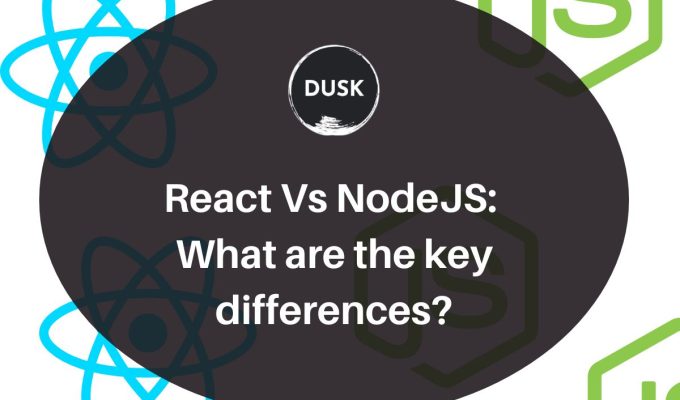Whether you are an amateur developer or an experienced developer, it is natural to have questions like what the key differences are between Node.js and React.js? Which one is better: between Node.js and React.js?
React is basically a front-end library, while Node.js is normally used at the server-side, or at backend. Neither React nor Node.js are from any similar category. They are totally distinct from each other.
The basic difference between Node.js and React.js lies in how both these technologies are utilized in web application design and web development. Basically, Node.js and React.js operate for different purposes in the area of web development. They are not interchangeable.
In order to understand the difference between Node.js and React.js, let us first understand in detail what both Node.js and React.js are.
What is React.js?
React.js is the Javascript library. It was developed by Facebook in 2013. This library was developed in order to upgrade and enrich the UI for the web apps. The framework has improvised a lot over time. React.js is open-source and backs various inbuilt modules and functions such as form module, routing module, and many more. ReactJS is also used by many developers to make single-page Web apps.
What is Node.js?
Node.js is a server-side language which makes use of a javascript runtime environment in order to implement the javascript code to execute outside the browser. Node.js is built on Google Chrome’s V8 JavaScript Engine. This means that applications that are created with Node.js are basically written in JavaScript, which makes it very simple, and can function within the runtime of Node.js on OS X, Microsoft Windows, and also Linux.
Node.js is an open-source framework and supports a lot of modules through NPM (Node Package Manager). Nodejs is a lot faster and robust.
Nodejs vs React: What are their usage statistics and how popular they are globally?
Let us now compare usage statistics and global popularity of both Nodejs and Reactjs:
Approximately 1,408,233 customers use Reactjs for their frontend development. Additionally, approx 10,418,340 live websites utilize React, and apart from them 2,306,019 sites have used it before.
According to Stackoverflow Survey 2021, React was the most sought after web framework.
According to Node.js User Survey Report, approximately 49.9% developers utilized Node.js. This made it one of the most used tools, libraries, and frameworks, in 2019.
Understanding the Comparison Parameters for Nodejs vs React
Difference #1: Learning curve
React
React brings to the table a comparatively simpler learning curve when compared to few others. This is because developers don’t need to invest time in learning the language of programming again. Simply speaking, React is developed on the language which developers are already familiar with i.e. JavaScript. Because of its straightforward design, immensely comprehensive documentation, and utilization of JSX, React is the superior library which makes web designing and development simpler to carry out and restate.
Node.js
In comparison to React.js, Node can be learned easily. However, implementation of web applications is more difficult and takes more effort. Furthermore, the presence of asynchronous programming which basically executes the non-blocking code makes it even more complicated. However, this actually does not affect or prevent the implementation of a piece of code. Sometimes, this is why it is complicated to program.
Difference#2: Microservices – Nodejs vs React
The concept of Microservices architecture is totally new. It is mainly utilized to revolutionize expansible backends. The definition of Microservices architecture is: an approach to develop a single page app as a suite of minor services. Each of these services runs its process and communicates with mechanisms that are lightweight.
The core purpose was to enable various teams to function effectively on individual and different characteristics of a web application. This type of approach boosts the productivity of developers and also simultaneously reduces time-to-market.
How Micro Frontends in React Work?
The idea of micro frontends presents a method to decompose a scalable and extendable frontend into lesser and more controllable chunks. During a certain period of time, specific developers and their team operate on these chunks till the time the code is all set to be deployed as groups of loosely coupled applications.
Furthermore, the team of developers is also accountable for a different set which primarily supports different content. Micro frontends that are present in React are more friendly and also a little bulky. React.js enables indirect communication of micro frontends internally, thus reducing direct coupling. Selecting React is a worthy solution which drives the procedure of passing data and callbacks downwards. This outcome frames the contrast even more explicitly.
How Microservices in Node.js Work?
In a way, Node certainly correlates microservices. This is because both work as a tech stack and allows organizations to gain security, suppleness, agility, and outstanding performance. By utilizing microservices along with Node enables you to create apps without any kind of complexities. This influential amalgamation can also strengthen highly-extensible apps and control thousands of synchronous requests without affecting the speed of the system.
By making use of microservices in node.js supported eCommerce apps authorizes various different services. It enables them to update and grow separately. If you are an eCommerce owner, hire remote node js developer to capitalize this feature.
Difference #3: Community Support
It is imperative for your developers to have extensive community support in order to work effortlessly on any project around and with the framework.
React
React.js is founded and managed by Facebook. Hence, it has the unquestionable support of a talented team that is always available for help. One of the positive aspects of it is that it receives frequent updates which enable developers to work effortlessly without any hitches. In this way, developers also learn and update themselves continuously. A lot of prevalent and widely used popular websites like Airbnb, Uber, Netflix, Asana, PayPal, and Khan Academy use React.
React has 188k Github stars and 1556+ Github contributors.
Node.js
Node.js, just like React, is also an open-source framework. This means that its community regularly and zestfully indulges in fixing occasional bugs and improvising the languages. The community which consists of talented developers have leading and finest tips at their disposal.
Node.js has 87.4k stars on Github and 3105+ Github contributors.
Here are some important takeaways regarding both Nodejs and React:
- Node offers speed, scalability, and of course, better performance. This is what makes it suitable for an assortment of various tasks.
- It is very easy and simple to make light-weight and attractive apps on both web and mobile.
React can function on the server-side. Meanwhile, the virtual DOM will be imparted. This will enable it to come back to the browser in the form of a normal web page.
- Both Node and React consist of huge and active community support.
Conclusion:
When comparing React with Node, it is as if apples are being compared with oranges. In comparison, one of them is a library for the frontend, whereas the other is a library for the core. However, both of them are very useful and here to stay!






